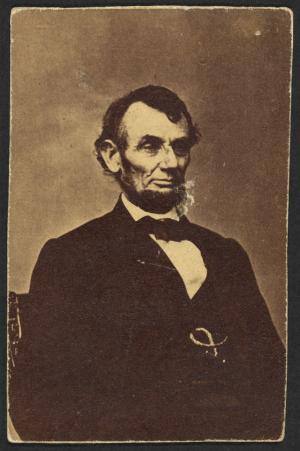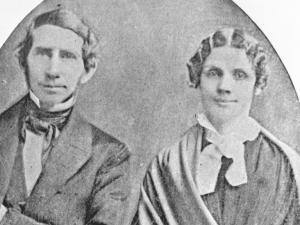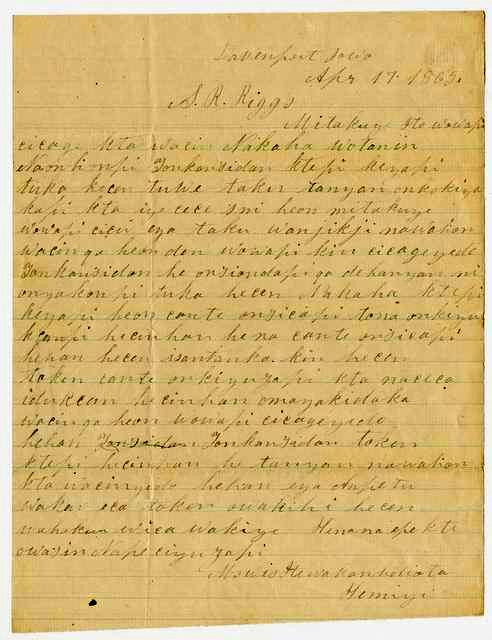Dakota Prisoner of War Letters
 Dakota men imprisoned at Davenport, Iowa after the war sent letters to Presbyterian missionary Stephen Riggs. He, in turn, shared their letters with family members. In their letters, the men detailed conditions in the prison, inquired about their futures, and asked Riggs to advocate on their behalf.
Dakota men imprisoned at Davenport, Iowa after the war sent letters to Presbyterian missionary Stephen Riggs. He, in turn, shared their letters with family members. In their letters, the men detailed conditions in the prison, inquired about their futures, and asked Riggs to advocate on their behalf.
Mowis Itewakanhdiota (Moses Many Lightning Face) and other condemned prisoners knew that President Lincoln had spared them from hanging, but their death sentences still had not been commuted. News of the president’s assassination in 1865 caused them great concern.
For decades, the letters have been stored with other Riggs family papers at the Minnesota Historical Society. In recent years, several translation projects have been underway. The Dakota Prisoner of War Letters: Dakota Kaskapi Okicize Wowapi, which contains fifty letters translated by Clifford Canku and Michael Simon, will be published in 2013 by the Minnesota Historical Society Press.
This letter, dated April 17, 1865, was sent from Mowis Itewakanhdiota to Stephen Riggs. To read the letter with the Dakota direct translation and modern Dakota English translation, hover over the image and then click on the red circles.
Permissions beyond the scope of this license may be available at Copyright and Use Information.
Related Images

Abraham Lincoln
Abraham Lincoln to Bishop Henry Whipple, September 1862
Born in 1809, Abraham Lincoln was the 16th president of the United States, serving from March 1861 until his assassination in April 1865. He led the United States through the Civil War, preserving the Union while ending slavery and promoting economic and financial modernization. As president, he played a critical role during the U.S.-Dakota War and its aftermath.
Reared in a poor family on the western frontier, Lincoln was mostly self-educated. He became a country lawyer, a Whig Party leader, Illinois state legislator in the 1830s, and a one-term member of the U.S. House of Representatives in the 1840s. After losing a Senate race to his arch-rival Stephen A. Douglas, Lincoln, a moderate, secured the Republican Party nomination for president in 1860. His election led to seven southern states seceding from the Union and the formation of the Confederate States of America--and eventually to war.
With the Civil War monopolizing the government’s attention, any attempts at reforming the Indian system that Abraham Lincoln might have hoped for simply never materialized. Lincoln dealt directly with the situation in Minnesota after the U.S.-Dakota War, calling for a review of the trial transcripts of 303 Dakota men sentenced to death. Lincoln commuted the sentences of all but 39 of the convicted men.
If Lincoln had stepped in earlier to address his administration’s handling of Indian affairs, events in Minnesota might have taken a different course.

Reverend Stephen and Mary Riggs
After spending time at Fort Snelling starting in June of 1837, Riggs and his wife, Mary, spent the summer with the Reverend Jedediah Stevens at Lake Harriet. They then traveled to Lac qui Parle where for five years they worked among the Dakota and translated the Bible into the Dakota language with the help of Joseph Renville Sr. He would eventually publish this dictionary with the help of the Minnesota Historical Society and the Smithsonian Institution.
In 1843 Riggs, with the help of Robert Hopkins, opened a Dakota mission at Traverse des Sioux, near modern-day St. Peter, Minnesota. Alexander G. Huggins was assigned to the station in 1846, and Riggs returned to Lac qui Parle to take the place of Dr. Williamson, who was transferred to work among the Dakota at Kaposia near modern-day South St. Paul, Minnesota.
In 1851, Riggs was one of the interpreters that helped explain terms to the Dakota signers at the Treaty of Traverse des Sioux. The treaty created changes in the locations of Dakota missions due to the Dakota moving onto reservations in the Southwest part of Minnesota. Dr. Williamson had chosen a new site on the Yellow Medicine River in 1852 which he called Payzhehooteze (the Upper Sioux Agency or Pezuhutazizi), and Riggs joined him there two years later. The Hazelwood mission and republic were then organized by the Riggs party near the Agency as an educational and agricultural center for Christian Dakota.
When the U.S.-Dakota War began, the Hazelwood party came down to the Upper Sioux villages. In the early morning hours of August 19, the Riggs family fled to their Christian Dakota neighbors, who hid them on an island in the Minnesota River, then guided them on their way toward safety that night. Riggs volunteered for service and was made the chaplain to General Sibley's forces. Hazelwood mission was destroyed and when the Dakota were exiled from Minnesota after the war, the missionaries traveled with them where they continued to set up mission stations. Riggs died in Wisconsin in 1883.

